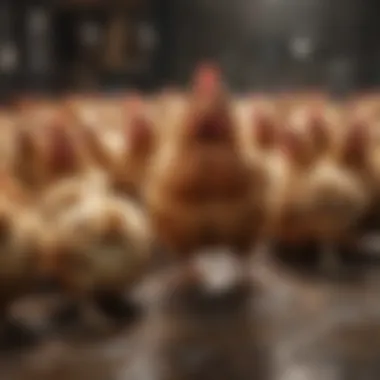Understanding the Reasons Behind Decreased Egg Production in Chickens


Intro
Egg production in chickens is a topic of significant interest for many owners and enthusiasts. While factors influencing egg laying are numerous, understanding them aids in maintaining optimal poultry health. Decreased egg production can stem from environmental conditions, age, nutrition, and various health concerns. Proper awareness is essential for chicken keepers who wish to enhance the well-being of their flock and improve egg output. In this article, we will explore these factors in detail, providing valuable insights and practical solutions.
Environmental Influences
Chickens are sensitive to their surroundings. Changes in weather, lighting, and housing conditions can greatly affect their laying patterns.
- Light Exposure: Chickens require a certain number of daylight hours to stimulate egg production. Typically, they need about 14 to 16 hours of light per day. Insufficient daylight, particularly in winter months, can lead to decreased egg output.
- Temperature: Extreme temperatures, both hot and cold, can stress chickens. In colder months, hens may conserve energy for warmth instead of laying eggs. Conversely, excessive heat can lead to overheating and reduced activity, which can also decrease production.
- Space and Housing: Adequate space is crucial for chickens. Crowded conditions lead to stress, aggression, and potential health issues that can impact egg laying. Proper ventilation in coop ensures a comfortable atmosphere.
Health and Wellness
The overall health of chickens directly correlates with their ability to lay eggs. Addressing nutritional needs and health concerns is vital for productive flocks.
- Nutrition and Diet Tips: An imbalanced diet can lead to a decline in egg production. Chickens require a diet rich in protein, calcium, and vitamins. Layer feeds specifically designed to meet these needs are available. Providing supplements, such as oyster shells for calcium, can also be beneficial.
- Common Health Issues and Solutions: Hens can suffer from various ailments. Conditions like respiratory infections, parasites, and egg-binding can hinder production. Regular health inspections and prompt treatment of suspected illnesses are essential to maintain their egg-laying ability.
- Importance of Regular Check-Ups: Routine veterinary visits help monitor the overall health of chickens and prevent potential issues that could affect their productivity. Keeping a close eye on their health ensures that any concerns are addressed before they become serious problems.
Maintaining optimal health and nutrition is critical for ensuring consistent egg production in your flock.
Summary
Understanding the reasons behind decreased egg production is crucial for any chicken owner. By managing environmental conditions and ensuring proper health and nutrition, you can help your hens remain productive. Addressing these factors will contribute not only to higher egg yield but also to the overall well-being of your flock.
Prelude to Egg Production in Chickens
Understanding egg production in chickens is crucial for anyone involved in poultry farming or chicken keeping. It encompasses more than just the act of laying eggs; it involves several biological, environmental, and health-related factors affecting a hen's output. Recognizing these elements is essential for ensuring not just productivity, but the overall well-being of the flock.
Chickens are remarkable creatures, and their ability to produce eggs can be influenced by a variety of aspects. Eggs serve as a source of nutrition and contribute to the livelihood of many. Hence, keeping chickens that lay regularly is a common expectation for pet owners and farmers alike. However, it is not always guaranteed. Factors affecting this can range from biological rhythms to external conditions.
There is interest in understanding the reasons behind decreased egg production. This knowledge helps in diagnosing problems and taking corrective measures. An informed approach leads to healthier chickens and optimal egg yield, enhancing satisfaction for the owners. Proper care is paramount, and awareness of the nuances involved aids in improving husbandry practices. The more one knows about these reasons, the better equipped they are to address issues as they arise.
In this section, we will elaborate on the biology of egg production, delving into the cellular processes at play. Furthermore, we will frame common expectations that owners may have and how to set realistic goals based on different factors that can impact production, including age, breed, and seasonal variations.
Understanding the Biology of Egg Laying
A hen's reproductive system is complex and fascinating. Egg production is part of a biological cycle influenced by hormones, nutrition, and environmental cues. Hens have an ovary that contains thousands of undeveloped yolks, or oocytes. As the hen matures, these yolks are released sequentially.
When a yolk is released, it enters the oviduct, where it undergoes several stages of development. The yolk is surrounded by layers, including albumen, membranes, and the shell. Each stage requires specific nutrients and conditions to proceed effectively. Hormones, particularly estrogen and progesterone, regulate these processes, dictating when and how often an egg is laid.
Nutrition plays a vital role in this whole perspective. Without adequate vitamins and minerals, a hen's body cannot produce eggs efficiently. For example, calcium is essential for shell formation. If the hen lacks this element, production may slow or cease altogether. Thus, understanding these biological processes is fundamental for anyone wishing to optimize egg production in their flock.
Common Expectations for Egg Production
When it comes to eggs and chickens, many owners have expectations shaped by various factors, such as breed, age, and historical data. Generally, a healthy laying hen can produce anywhere from 250 to 300 eggs per year.
- Breeds: Different breeds have varied rates of production. For instance, breeds like the Leghorn are known for laying frequently, whereas others, like the Orpington, may not produce as many eggs but are valued for their meat quality.
- Age: A hen's egg-laying capability often reaches its peak around 6 months of age and may continue well into her second year. After that, the output typically declines.
- Seasonal Variations: Seasonal changes can significantly impact egg-laying patterns due to factors such as daylight hours. Hens need a minimum of 12 to 14 hours of light for optimal egg production.
It’s important for chicken keepers to align their expectations with these natural variations. Understanding these dynamics not only aids in fostering realistic goals but also in developing effective management strategies. Recognizing these benchmarks can prevent frustration and guide caretakers to ensure that their chickens lead healthy and productive lives.
Environmental Factors Affecting Egg Production
Understanding the environmental factors that affect egg production is crucial for any chicken keeper. These factors can have a profound impact on your flock's capacity to lay eggs. Recognizing and managing these elements can improve the well-being of the chickens and enhance their egg-laying performance. When managing a poultry farm or simply keeping chickens as pets, awareness of these environmental influences ensures optimal conditions for egg production.
Impact of Seasonal Changes
Chickens are sensitive to seasonal variations. As the seasons shift, so do the ambient temperatures, light duration, and humidity levels. During colder months, chickens may decrease egg production due to reduced daylight hours and lower temperatures. Chickens need around 14 to 16 hours of sunlight daily to maintain optimal laying conditions. In contrast, warmer months can increase egg production if proper cooling measures are in place. However, extreme heat can also lead to stress, negatively affecting their laying capacity. Understanding your local climate can help you adapt your management practices accordingly.
Humidity and Temperature Considerations
Humidity and temperature are tightly linked and significantly affect the chickens' health and egg production rates. High humidity can result in heat stress, which reduces feed intake and thereby decreases egg-laying. Furthermore, inappropriate temperature levels, whether too high or low, can weaken the chickens' immune systems, making them susceptible to diseases. A temperature range of 65 - 75°F is generally ideal for laying hens. Monitoring temperature and humidity will help improve the chicken's comfort and maintain their egg-laying performance.


Lighting and Egg Production
Artificial lighting plays a critical role in managing egg production. Providing consistent light exposure can trick chickens into thinking it's a longer day, thus encouraging them to lay more eggs. Most commercial operations use artificial lights to regulate the laying cycle. The typical practice is to maintain around 14-16 hours of light per day. Moreover, the quality of light—its intensity and color—also matters. Hens respond well to bright, white light, which can stimulate activity and engagement, leading to an increase in egg output. Adjusting lighting schedules can be a straightforward and effective way to enhance production.
Important consideration: The transition into and out of artificial lighting should be smooth to avoid stressing the birds.
By addressing these elements—seasonal changes, humidity and temperature, and lighting management—you can significantly influence your chickens' egg production capacity. This understanding equips you to maintain an environment conducive to optimal laying, ultimately contributing to the health and productivity of your flock.
Health Issues that May Cause Decreased Egg Production
The topic of health issues affecting egg production is crucial to understanding why chickens may stop laying eggs. Healthy hens are more likely to produce eggs consistently. When health problems arise, egg production can decline significantly.
Nutritional Deficiencies
Nutritional deficiencies can play a significant role in egg production. Chickens require a balanced diet rich in proteins, vitamins, and minerals to lay eggs effectively. Common deficiencies include lack of calcium, vitamin D, and protein.
- Calcium: Essential for eggshell formation. Without adequate calcium, eggs may be soft-shelled or absent.
- Vitamin D: Helps in calcium absorption. A deficiency can lead to poor bone health and lower egg production.
- Protein: Necessary for the development of egg yolks. A lack of protein can lead to fewer eggs being produced.
To ensure proper nutrition, chicken keepers should monitor feed qualities and adjust diets accordingly. Nutritional supplements may also help restore deficiencies.
Common Diseases and Their Impact
Various diseases can reduce egg production. Recognizing symptoms early is key to preventing long-term issues. Common diseases include:
- Infectious Bronchitis: Causes respiratory issues and reduced egg yields. Symptoms may include coughing and nasal discharge.
- Newcastle Disease: A viral infection that can cause reduced egg production and other severe symptoms.
- Egg Drop Syndrome: Leads to a sudden drop in egg production. Affected hens may lay fewer eggs or none at all.
Regular health check-ups and vaccinations are vital in preventing these diseases. Treatments may vary from antibiotics to supportive care, depending on the illness.
Parasites and Their Role in Egg Laying
Parasites can also have a considerable impact on egg laying. They can cause stress and discomfort, which in turn affects production.
Common parasites include:
- Worms: Intestinal parasites rob hens of nutrients. They can lead to poor body condition and lower egg output.
- External parasites: Such as mites and lice can cause skin irritations, stressing the birds.
It is crucial to maintain hygiene and implement regular deworming protocols to reduce the impact of parasites. Adequate living conditions can also help prevent infestations.
Regular health evaluations are essential to identify any underlying issues that may cause decreased egg production.
Overall, addressing health issues is vital for restoring egg laying capacity in chickens. A proactive approach to diet, disease management, and parasite control can lead to better outcomes for egg production.
Behavioral Aspects Influencing Egg Laying
Understanding the behavioral aspects influencing egg laying is essential to comprehend the overall health of a chicken flock. Chickens are lively creatures with complex social interactions. These interactions can affect their productivity, particularly egg production. Poor behavior among chickens can stem from various sources, including stress and social hierarchies. Recognizing these issues can help chicken owners implement effective strategies to encourage better egg-laying conditions.
Stress and Its Effects on Chickens
Stress is a significant factor that can impede egg production in hens. Various causes of stress exist, including abrupt changes in environment, handling techniques, and even bullying from other chickens. When hens experience stress, their bodies can release high levels of stress hormones. Such hormones interfere with the hormonal balance necessary for egg production. This situation can lead to a decrease in egg frequency or even a complete halt.
Animals, much like humans, showcase physiological and behavioral symptoms when under stress. Symptoms include:
- Feather picking
- Aggression
- Decreased social interactions
Chicken keepers must be observant. Addressing the source of stress promptly can prevent further issues. Practical steps include
- Maintaining a calm environment: A serene setting can help reduce stress levels.
- Handling practices: Gentle handling minimizes fear and anxiety.
- Proper flock composition: Ensure that no chicken dominates others excessively.
By taking care of these aspects, chicken keepers can maintain a productive environment conducive to egg production.


Social Hierarchy and Its Impact
Social structure within a flock significantly influences behaviors and productivity. Chickens establish pecking orders, determining the dominance and social standing of each bird. In instances where the hierarchy is being challenged, stress can occur, impacting egg production. Dominant birds may bully less assertive hens, leading to behavioral changes that affect laying.
Aspects of social hierarchy include:
- Dominance: Some hens may constantly assert themselves over others, leading to stress in subordinate chickens.
- Resource Allocation: The dominant birds often access food and space first, which can leave subordinate hens nutrient-deprived.
Chicken owners should monitor their birds for signs of bullying. To mitigate issues created by social hierarchies, consider integrating new members gradually or rearranging the flock, ensuring a balanced approach.
Understanding social behaviors and their impacts can lead to better management techniques for healthier chickens.
Partnering attention to behavioral aspects with environmental assessments can improve egg production remarkably. Effective management requires vigilance and adaptability to foster optimum conditions for laying.
Assessing Your Chickens: A Practical Guide
In order to address decreased egg production in chickens, it's essential to first assess the overall health and environment of your flock. Understanding the specific factors that influence egg-laying will help you implement effective solutions. Evaluating the conditions of your chickens allows you to make informed decisions and improve their well-being and productivity. Consultations with veterinarians or poultry specialists can also provide valuable insights.
Identifying Signs of Stress or Illness
Recognizing signs of stress or illness in chickens is critical for maintaining egg production. Chickens express discomfort both physically and behaviorally. Key indicators may include:
- Reduced activity levels: Chickens that are lethargic may not be feeling well.
- Decreased food intake: A sudden drop in appetite often signals an underlying health issue.
- Changes in droPPings: Abnormal droppings can signify various diseases or dietary problems.
- Feather pecking: Stress often leads to aggressive behaviors among flock members.
- Vocalizations: Excessive squawking or aggression may indicate stressors.
To ensure your flock's health, regularly observe their behavior and appearance. Identifying these signs early can help you take prompt actions, whether healthcare intervention or environmental adjustments.
Nutrition and Diet Evaluation
The nutrition of your chickens plays a significant role in their egg production capabilities. An inadequate or imbalanced diet can lead to a decline in egg laying. To evaluate the nutrition your flock receives, consider the following:
- Quality of feed: Ensure that you are using a balanced feed formulation appropriate for their age, breed, and production stage.
- Access to fresh water: Chickens require constant access to clean water for optimal digestion and egg production.
- Supplement inclusion: Adding vitamins, minerals, or other supplements can alleviate deficiencies that may affect egg output.
- Assessment of treats: Treats should not exceed more than 10% of their total diet to prevent nutritional imbalances.
Regularly review feed formulations and consider consulting with a poultry nutritionist if necessary. Nutritional balance is crucial for supporting both the health of your chickens and maximum production.
Environmental Assessment Checklist
A comfortable and suitable environment is essential for maintaining healthy egg production. When assessing your chickens' surroundings, use the following checklist:
- Shelter: Examine the coop for proper ventilation, space, and protection from predators.
- Bedding: Provide dry, clean bedding materials. Wet bedding can harbor bacteria and lead to health issues.
- Temperature and humidity: Ensure the living area is within an acceptable temperature range, as extreme weather can negatively impact egg production.
- Light exposure: Continuous lighting for about 14-16 hours a day can promote higher egg production, particularly during winter months.
By systematically evaluating each aspect of their environment, you can identify areas that may need improvement and help create an atmosphere conducive to egg laying.
Regular assessments and adjustments can significantly enhance overall productivity and chicken well-being.
Interventions to Restore Egg Production
Restoring egg production in chickens is crucial for both productivity and overall well-being of the flock. When layers experience a drop in egg output, it can be concerning for chicken keepers. Understanding how to intervene effectively can help you minimize losses and ensure that your chickens remain healthy and productive. This section outlines various interventions that can be employed to restore egg production.
Dietary Adjustments and Supplements
Diet plays a significant role in the health and productivity of chickens. Making proper dietary adjustments can help address deficiencies that might hinder egg laying. It is essential to offer a balanced diet that meets the nutritional needs of your hens.
Some key elements to consider include:
- Protein Levels: Ensure that hens receive adequate protein. High-quality layers feed typically contains around 16-18% protein. Find feeds enriched with amino acids for better results.
- Calcium: This mineral is vital for shell formation. Providing crushed oyster shells or limestone can enhance calcium intake.
- Vitamins and Minerals: A supplement containing vitamins A, D, and E, along with minerals such as zinc and selenium, can support better egg production.
Frequent shifts in the diet can lead to digestive issues. Therefore, any changes should be gradual. Monitoring your flock’s overall health will help you make informed adjustments.
Improving Living Conditions


The living environment of chickens greatly influences their productivity. A comfortable and clean habitat can promote better egg production. Consider modifying the living conditions according to these aspects:
- Space: Overcrowding can create stress and disrupt laying patterns. Aim for at least 4 square feet per hen in the coop.
- Ventilation: Proper airflow minimizes humidity and prevents respiratory issues. Ensure adequate ventilation while shielding from drafts.
- Bedding: Clean, dry bedding helps control pathogens and maintain health. Change bedding regularly to reduce the risk of diseases.
- Nesting Boxes: Ensure ample, clean nesting boxes for your hens to lay. A minimum of one box for every four hens is a good rule.
By enhancing living conditions, you reduce stressors and create an environment conducive to egg production.
Stress Reduction Techniques
Stress is detrimental to chickens and can severely impact egg laying. Understanding and mitigating stress factors is crucial for restoring production. Consider the following techniques:
- Quiet Environment: Keep the surrounding noise to a minimum, especially during the laying period. Loud sounds can frighten hens.
- Social Structure: Ensure the flock dynamics are stable. Introductions of new chickens should be gradual to prevent pecking order disputes.
- Consistent Routine: Chickens thrive on routine. Regular feeding and watering schedules can help them feel more comfortable.
- Handling: Limit handling and interventions during the peak laying times, as this can create stress.
Implementing these stress reduction techniques may improve egg laying in the flock and maintain a healthy environment.
It is crucial to actively monitor both environment and health. Small changes can lead to significant improvements in production.
In summary, restoring egg production requires a focus on diet, living conditions, and reducing stress. Chicken keepers equipped with this knowledge can better manage their flocks, ensuring a healthy and productive environment.
Long-Term Care Strategies for Optimal Egg Production
Maintaining optimal egg production requires long-term strategies. It is not just about fixing immediate issues. Instead, a holistic approach is crucial. By preparing a stable environment and ensuring proper care, the chances of sustained egg production increase.
Establishing a Balanced Diet
A balanced diet plays a crucial role in egg production. Chickens need various nutrients to produce eggs effectively. Key elements include:
- Protein: Essential for the formation of egg whites and overall health.
- Calcium: Vital for strong eggshells.
- Vitamins: Such as A, D, and E, which assist in reproductive health.
It's important to offer layers' feed specifically designed for chickens. This feed typically contains a balance of grains, vitamins, and minerals. Additionally, incorporating grains like corn and oats can help in ensuring energy levels remain high. However, always provide fresh water to complement the diet as hydration impacts laying efficiency.
Ongoing Health Monitoring
Consistent health checks are necessary for any flock owner. Regular monitoring helps in catching issues before they become serious. Some practices include:
- Daily Observation: Look for any unusual behaviors or signs of distress in your chickens. Pay attention to their activity levels, eating habits, and general demeanor.
- Scheduled Health Checks: Implement veterinary check-ups. A veterinarian specializing in poultry can provide more in-depth care recommendations.
- Vaccination and Disease Prevention: Keeping up with vaccinations and treatments prevents outbreaks that can diminish egg production.
By staying proactive about health monitoring, chicken keepers can identify potential issues that may affect egg laying.
Adapting to Changing Conditions
Environmental factors change, and chickens need proper adaptations to thrive. Seasonal changes can have significant impacts on egg production. To adapt, consider the following:
- Climate Control: In extreme heat or cold, provide shelter and proper ventilation to maintain comfort.
- Lighting Adjustments: As day length varies, using artificial lights can help maintain consistent laying habits in winter months.
- Behavioral Considerations: As chickens grow older, their laying patterns may alter. Older chickens may lay fewer eggs. Adjusting care strategies for older hens can improve their comfort and production.
Understanding and adapting to changing conditions ensures that chickens can maintain productivity throughout their lifecycle.
The End: A Holistic Approach to Egg Production
A thorough comprehension of decreased egg production requires a multifaceted view. This conclusion emphasizes the importance of considering various components in chickens' lives. By taking a holistic approach, chicken keepers can address multiple influences concurrently. This approach is essential for ensuring optimal egg production and the overall health of the flock.
Integrating care practices can lead to better livestock management. It encourages a dynamic form of caregiving that responds to the specific needs of chickens. This means creating an environment that minimizes stress and fulfills dietary demands. By observing their chickens closely, owners can adapt and modify practices as needed. Understanding their behavior and physical conditions can guide interventions more effectively.
Integrating Care Practices
When administering care to chickens, integration of various practices is crucial. Focus on consistent observations and adjustments. Key areas to consider include:
- Diet: Ensure a balanced nutritional plan with adequate protein, vitamins, and minerals. High-quality feeds are essential.
- Living Conditions: Improve shelter quality. Proper ventilation, cleanliness, and space can minimize stressors.
- Health Monitoring: Regular health checks play a significant role. Conducting routine examinations can help identify issues early. Monitor behaviors and egg-laying patterns closely to spot abnormalities.
Encouraging positive interactions amongst the flock is also important. Chickens thrive in a stable social environment. Introducing new birds should be done gradually to avoid conflicts. The ultimate goal is to create a harmonious living situation that promotes well-being and maximizes egg production.
Future Considerations for Chicken Keepers
As chicken keepers look ahead, several future considerations should be integrated into their practices. The industry is evolving, and it’s crucial to stay informed about new research and developments. Key points include:
- Adapting Practices: Owners may need to modify their management techniques over time. Changes in environmental conditions, such as climate change, will impact care. Keeping abreast of trends can inform adjustments in feeding and housing practices.
- Education and Training: Engaging in workshops and online courses can enhance knowledge of poultry care. Gaining insights into modern practices ensures that keepers remain effective and informed. Resources like Wikipedia and Britannica can provide valuable information.
- Sustainability Efforts: Transition towards sustainable practices enhances both the environment and chickens’ health. Keeping ecological principles in mind can reduce chemical usage and improve overall farm resilience.







